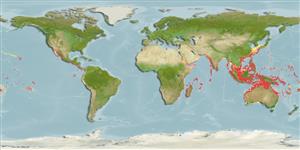Common names from other countries
Environment: milieu / climate zone / depth range / distribution range
Écologie
Récifal; profondeur 0 - 100 m (Ref. 99185). Tropical
Indo-West Pacific.
Length at first maturity / Taille / Poids / Âge
Maturity: Lm ? range ? - ? cm Max length : 17.0 cm TL mâle / non sexé; (Ref. 92)
Description synthétique
Morphologie
One of the most brightly colored stomatopods; with deep blue uropods; those and other appendages lined with bright red setae (Ref 92).
Intertidal to subtidal (Ref. 106854). Lives in existing burrows in shallow and rough bottom habitats, often on or near coral reefs (Ref. 92), and on reef flats at a depth of 36 m (Ref. 80410). Feeds on scyllarids; active during the day; uses its buttressed raptorial claws to smash hard-bodied prey. Largest 'smasher' (Ref. 92).
Life cycle and mating behavior
Maturité | Reproduction | Frai | Œufs | Fécondité | Larves
Some members of the order Stomatopoda pair for life and some come together only to mate. Males produce sperm ducts rather than spermatophores; females can brood a maximum of 50,000 eggs. Life cycle: Eggs hatch to a planktonic zoea which lasts for 3 months.
Manning, R.B. 1998. (Ref. 92)
Statut dans la liste rouge de l'IUCN (Ref. 130435)
statut CITES (Ref. 108899)
Not Evaluated
Not Evaluated
Menace pour l'homme
Harmless
Utilisations par l'homme
Aquarium: Commercial
| FishSource |
Outils
Plus d'informations
Taille/ÂgeCroissanceLongueur-poidsLongueur-longueurMorphologieLarvesAbondance
Sources Internet
Estimates based on models
Preferred temperature
(Ref.
115969): 24.3 - 29, mean 28 (based on 1610 cells).
Vulnérabilité
Low vulnerability (10 of 100).
Catégorie de prix
Unknown.
